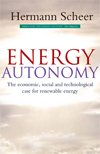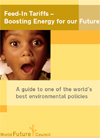 Article published in UNEP Our World Magazine, December, 2005
Article published in UNEP Our World Magazine, December, 2005Hermann Scheer describes how photovoltaic solar energy conversion offers humanity a unique opportunity and calls for political programmes to promote it. Photovoltaic energy (PV) is the primadonna of renewable energy technology. Currently, it only generates just a small part of total renewable energy supply, less than wind, hydro power or biomass. But it also bears by far the biggest potential - larger than that of all other renewable energy sources, larger than anything to which fossil fuels and nuclear power could ever aspire. Photovoltaics are the most promising of all energy technologies, giving us the best option to overcome global energy crises.
The global primary energy potential of fossil fuels and uranium is concentrated at a few geographically limited sites: so they need long supply chains to most of their consumers, which in turn cause high transmission and distribution costs and important losses of energy. The primary energy potentials of hydro power, windpower and biomass may be spread much more widely, but their technical and economic usability is still limited by topographic constraints and depends, for example, on good regional wind speeds and soil quality.
Solar energy radiation is the only primary source directly exploitable at every place on earth . It therefore offers everyone free access to energy - and, moreover, to electricity, that most modern and multifaceted form of energy services. Thus PV facilitates energy freedom for everybody,- free from discrimination, artificial national borders and administrative hurdles, and free from dependency on energy monopolies.
Moreover, PV technology makes modular electricity production possible. Every single PV module can work independently, whether it measures 5 square centimetres or 5 square metres, giving the technology unique flexibility.
Its wide range of applications varies from solar modules in calculators, cellular phones, power books and ventilators, and installations on roofs and façades to PV power plants made up of millions of modules, which can be constructed in arid and semi-arid regions. Installations can follow demand, on a “just in time” basis – thus avoiding misdirected investment - as upgrading with additional modules is always possible. Installation can be carried out exactly where the electricity is needed, avoiding the construction of a costly transmission network. It can therefore provide electricity immediately to two billion people without any connection to the power grid.
Even more importantly, PV modules can be installed within a few hours, big PV power plants in just weeks – in contrast to the several years of construction required by fossil fuel or nuclear power plants . This makes photovoltaics particularly attractive in areas of the world where rapidly increasing energy demand has to be met.
PV – like windpower – consumes not a single drip of water, in contrast to the immense amounts used by fossil fuel and nuclear power plants. This gives it a further advantage, especially when consumption for conventional energy supply competes with a direct demand for water by people and agriculture.
It also makes entirely decentralised energy independence possible. The opportunities for PV applications broaden as decentralised electricity storage develops – through lightweight electrochemical batteries which have no environmental impact and do not need many charge cycles; through electrostatic storage with super capacitors; through electromechanical options like fly-wheels and compressed air, or electrodynamic ones like superconducting magnets; and through using hydrogen or thermochemical methods.
Cost dynamics also favour PV. Its economic rationale lies in avoiding expenses - like fuel, grid and external environmental costs - that are inevitable in conventional electricity production. So its cost is constantly decreasing through economies of scale and technological improvements while conventional energy is experiencing equally constant increases in fuel and grid costs , as well as in water consumption and environmental damage.
Just one question remains: How can mass production of PV be initiated and how can investments in the technology be financed. These are one-time investments: the only running costs are for maintenance. They require long-term loans, especially where micro-credit is needed.
If it is to take off, PV needs political promotion schemes, which transform its advantages for national and environmental economics into incentives for individual investment. A variety of political instruments already exist - from loans at low and zero interest rates to legally fixed feed-in tariffs such as provided under the German Renewable Energy Act.
Such political initiatives are justified, both because nuclear power has received about US$ 1 trillion in subsidies over the last 50 years, and because direct and indirect subsidies for fossil fuels add up to around US$ 500 billion. Accelerating the development of renewable energy will cost much less and have long term economic, ecological and social benefits. It will, for example, help prevent further international conflicts over energy resources. And photovoltaic solar energy conversion can create good lives with access to modern communication in the developing world’s villages, thus preventing hundreds of millions of people migrating into the ever increasing slums. And meanwhile a new solar architecture can clean up the cities of the industrialised world.
Thus political schemes for promoting photovoltaics will guarantee a cheap, ecological and secure future energy supply for everybody.
Dr Hermann Scheer is President of EUROSOLAR and General Chairman of the World Council for Renewable Energy (WCRE).



